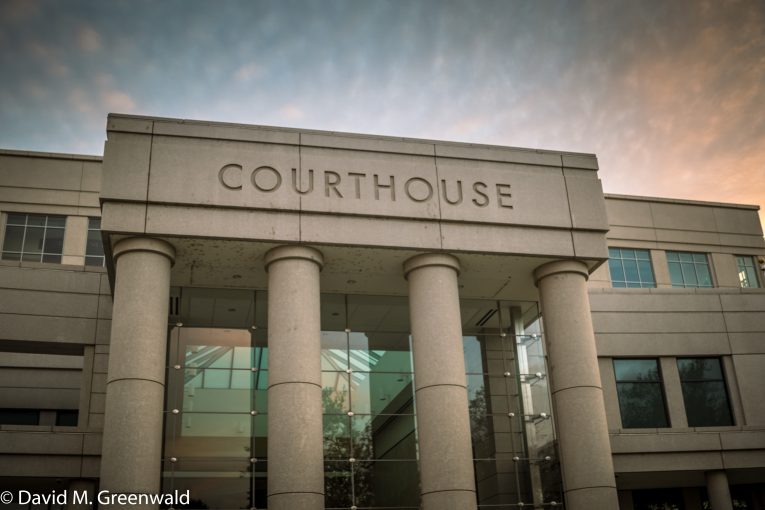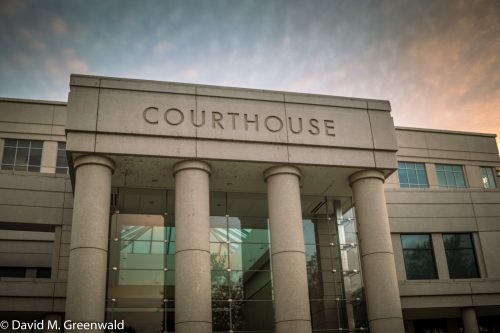
 By Jenean Docter
By Jenean Docter
Mr. Markeese Leavell Carter appeared in custody for his preliminary hearing in Department 13 on Friday, December 8. He is represented by Deputy Public Defender Ron Johnson. Carter is held on three counts: first-degree murder, sexual acts with a child ten years old or younger, and resisting an officer by means of physical force or threats.
The People, represented by Carolyn Palumbo, called a Yolo County Sheriff’s Deputy, Detective “JC,” to testify as a witness.
On the night of November 19, 2017, JC was dispatched to a housing unit at the El Rio Villas complex just east of Winters. The sergeant advised him that a minor had drowned, and that her father was behaving aggressively.
JC arrived on the scene around 6:40 p.m. that night, where he was met by the suspect’s 19-year-old brother, WR, and his 16-year-old sister. WR led JC to the location of the incident, a sandy, beach-like area that led into the creek, which was about 50 to 60 feet from the housing complex. JC noted that there was a military-style camouflage poncho covering the items left on the shore.
WR informed JC that the night prior to the crime, Carter had informed him that he had argued on November 17 with his wife regarding his eldest daughter’s parentage. Carter believed that the four-year-old, Aminatu-Amaya Abdul-Raafi, had been born of infidelity between his wife and one of his friends.
The next day, Carter’s mother allegedly came to pick up her son and his two daughters from their residence in Sacramento, and transported them to her home in Winters for the weekend.
According to WR, Carter washed dishes and cleaned his mother’s residence. WR packed lunches for Carter and his daughters, which consisted of peanut butter and jelly sandwiches, Cheetos, oranges, 
and Kool-Aid. Carter placed the lunches in a backpack before heading to the park and nearby creek with his two daughters on what he termed, during a later interview with JC, an afternoon “nature walk.”
WR informed JC that Carter returned soaked with water and acting frantically. Carter returned with his younger daughter, two-year-old “FR,” whom he then left with WR. WR next entrusted FR to a neighbor, and quickly followed after Carter in an effort to help his seemingly-panicked brother.
WR found Aminatu-Amaya lying on her back on the sand near the creek, and he performed CPR on her. A male medic arrived and brought her to medical personnel, who had arrived on the soccer field in the center of the housing unit. Carter allegedly told WR that Amaya drowned because he “wasn’t paying attention.” Carter had initially told JC that he blacked out while his daughters were playing on shore, and awoke when he heard his daughter screaming.
Cater acted aggressively toward the first responders on the scene, purportedly attacking them and lying on top of Amaya in an effort to prevent them from placing her on a gurney and transporting her to a hospital.
JC attended Amaya’s autopsy on November 20. In response to evidence of sexual assault offered by nurses at the hospital, authorities called a forensic pathologist and a sexual assault specialist to assist. The evidence was confirmed.
JC asked Carter during an interview on November 20 if he had sexually assaulted his daughter, and was met with rage. Carter, held by a single pair of handcuffs in front of his body, stood up and propelled his shoulder into JC’s face. A photograph of JC’s consequent injuries, including two half-inch lacerations to his lip, were admitted into evidence.
The next day, Carter requested another interview with JC. He met with the detective around 4:30 p.m., and presented a new narrative of the events leading up to his daughter’s untimely death, contrary to statements he had previously provided.
JC reflected that “the information developed in pieces” during the one-and-a-half-hour long interview. Carter told the officer that he intended to kill Amaya, and cited her disputed parentage as his motivation. When asked by JC why he did not kill his younger daughter, he responded that “she was his family.”
Carter informed JC that he took his daughters to the creek, where they had a picnic. He fed Amaya about three-quarters of a peanut butter and jelly sandwich, to which he added six pills. The drugs included prazosin, mirtazapine, and trazodone—prescription antidepressants and anti-anxiety medications he had been taking to treat the “fairly severe mental illness” his family claimed he suffered from. They claimed they he had served in the military, and since then suffered from PTSD and schizophrenia. Carter also claimed he experienced blackouts.
Samples of Amaya’s blood were collected from her heart during the autopsy, and sent to NMS Labs, a clinical and forensics laboratory in Pennsylvania. The report returned by the institute, admitted into evidence, indicated that caffeine, theobromine, and a drug caused by the breakdown of prazosin and trazodone were present in her body.
However, the levels were said to be “therapeutic” and not necessarily lethal. The drugs would have only affected her body if at an elevated level. Nonetheless, the institute reported that the substances found should not have been in the body of a four-year-old.
Carter initially claimed that he did not intend to kill her by poisoning her sandwich with the medications. However, during his second official interview with JC, he asserted that he fully intended to kill her with the drugs. One of the pill bottles used was later found in the river.
Carter communicated to JC that he plotted to frame one of his friends for the crimes of kidnapping Amaya, sexually assaulting her, and murdering her.
The “friends” that Carter allegedly planned to frame—”Abdul Karim” and “Tony Diaz”—may not even exist. Neither have been located, and the defense noted that “Tony Diaz” is the name given to the detention center to which Carter was transported following the incident.
JC informed the court, with the Honorable Paul K. Richardson presiding, that Carter claimed he killed his daughter himself because “the plan had changed.” When asked why, Carter allegedly responded “I don’t know, I was mad, I don’t f—in’ know.”
While his younger daughter was playing with toys, her back turned to the incident, Carter allegedly manually damaged his unconscious daughter’s anus in order to believably accuse his friend of sexually assaulting her. The court ruled his actions sufficient to constitute sexual assault, since he fully intended to cause his daughter harm.
Carter claimed that he then picked up his eldest daughter with both hands, and tossed her halfway into the creek. After a period of time, he jumped into the water, pulled her out, and performed several compressions on her because he was CPR certified and “needed to make it look like he tried” to save his daughter’s life.
The court ruled that all counts were satisfied for the purpose of a preliminary hearing. Yet, the contradictory statements given by Carter since the incident prompted the defense to inquire as to whether his admission of intent to frame his friend for his daughter’s murder was actually consistent with his actions. JC acknowledged that he did not investigate the inconsistencies present between Carter’s interviews.
In addition, the defense claimed that Carter often exhibits “involuntary jerking and grumbling.” JC would not confirm these movements as involuntary, but did affirm that Carter behaved in such a manner during questioning.
In spite of communicating clearly during interviews, as JC mentioned, Carter did exhibit evidence of mental illness. He described “voices in his head” that told him he “had to choose” between his daughters. He appeared slumped over, and frequently leaned to one side while sitting for his preliminary hearing. Carter also behaved aggressively when being escorted out of the courtroom, shouting and appearing to engage in physical altercation with the bailiffs attempting to restrain him.
What we have been left with is a deeply upsetting case pieced together from conflicting details, in which tragedy is the only certainty.
Aminatu-Amaya was pronounced dead after arriving at Sutter Davis Hospital. She would have turned five on December 4.
